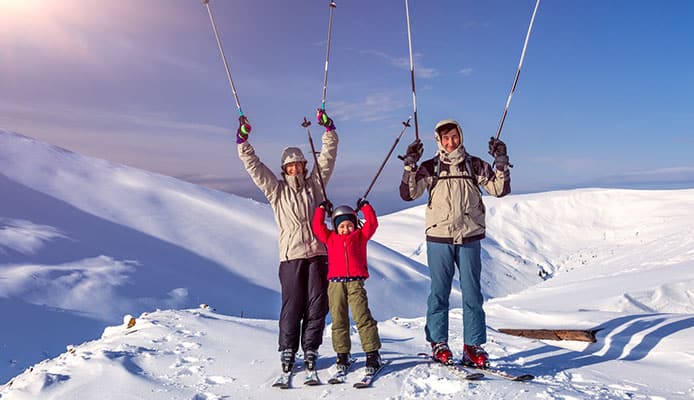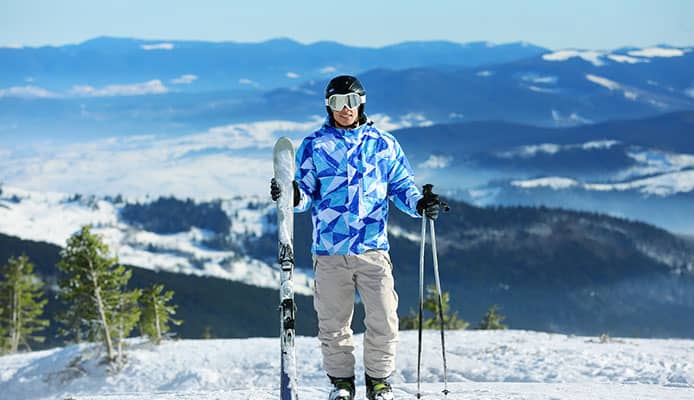
Skiing can be addictive. That feeling of gliding along the ice and even cascading down steep mountains offers thrills unlike any other. To help you make the most of your skiing adventures are ski poles. They can be used to propel you forward when skiing on relatively flat terrain and are most effective after doing the correct ski pole sizing.
What’s more, ski poles will also allow you to make much sharper turns by providing you with great balance and rhythm when going down a steep slope. Before grabbing those ski poles and heading uphill, you must start by understanding what to wear skiing.
Why you need ski poles in the first place
Providing the skier with a balance is perhaps the main benefit of using ski poles. They also allow the skier to propel themselves forward to gain extra momentum when riding the slopes.
When you are doing backcountry hiking with your friends in the snow, the poles are a great way to gain a better grip. They also make it easier to skate. You can much easily pull your weight and even pull your friends if need be.
If you are just starting skiing, then you will not use poles up until you get used to different terrains. If you started your skiing by using poles, you are prone to getting your body used to make the wrong moves and leaning positions. These include leaning on one side a bit too much, standing up straight, and even dragging too much.
Note that when choosing the right clothes, a snowboard jacket will work just fine when skiing.
It explains why you will often see beginners without poles and instead of leaning and holding their knees. This allows their body to develop muscle memory in the right-leaning positions.
After they have achieved that only then can they commit to using ski poles.
The fit of the pole
You will need to carry your ski boots in your ski boot bag when picking the ski poles that fit you. Wear them and stand straight. Turn the poles upside down such as the handle is touching the floor. Next, grab the ski poles right under the basket allowing your thumb to touch the basket itself.
Now check the angle of your elbow. If you have achieved the right ski pole sizing, then the elbow should be at a 90-degree angle. If it is more than this then it means that the ski pole is too short and you need to try a longer pole. If it is less than 90 degrees then the ski pole is too long and you need a shorter pole.
That said, it is recommended that pipe and park skiers choose shorter ski poles. The shorter the pole the less likely it will be caught up in the wall of the halfpipe.
The strap
When selecting the best ski poles, you also need to consider the strap. Nylon is the best material for straps as it allows the poles to maintain their position in case the skier loses their grip. Also, in case, you slide off balance and fall, you will still be able to access your poles as the straps will keep them attached to your hands.
Note that there are right and wrong ways to use the straps. Your hand needs to go through the strap from the bottom up. Also, the thumb grip and the handgrip need to go over the straps as well as around the pole.
If you are a beginner take time to learn how to ski before you can move on to using ski poles.
The best way to choose skis poles with the best straps before making the purchase is to wear your gloves and try them on. This will make it easier for you to wear them and remove them at will.
Modern ski poles now feature detachable straps allowing the user to easily wear and remove them.
The basket
Located at the bottom of the ski pole is a plastic design that looks like a snowflake. The function of this part of the pole is to prevent it from going into the snow too deep when in use.
It’s important to note the type of snow that you will be skiing on. If it is too powdery and less compact, you will need ski poles with a larger basket. On the other hand, if the snow is compacted, then you can do it with a smaller ski basket.
The best ski poles will feature interchangeable baskets. This allows the user to change the basket during ski pole sizing depending on the conditions resulting in much more versatile poles.
Telescoping poles
These are the poles of choice by mountaineers. They can be extended to allow for ascents or even shortened when making descents. There are even models that allow the mountaineer to attach both poles resulting in one long pole which can be used to probe for avalanches. Make sure you are well versed in how to survive an avalanche before heading out to the mountains.
If you are one for the telescopic pole, a rule of thumb is to check whether they are around waist height when skiing downhill and extended to under the armpit length for better striding.
Different types of ski poles

There are many different types of ski poles designed to suit a variety of terrains and conditions.
Alpine ski poles
These are the type that you are going to see often with many skiers. They are designed to be comfortable to hold and have a straight profile. These will also either feature small baskets or large baskets depending on the type of snow.
Powder ski poles
As the name suggests, these ski poles are designed for powdery snow that is soft and less compact. Because of this, they often feature a large basket designed to prevent the ski pole from sinking too far.
Some of the models available are also adjustable in height and have a tough shaft which allows the pole to withstand rocks and branches that the skier may come across.
Also, you will benefit from knowing how to buy skis.
Park poles and freestyle ski poles
These feature a thin shaft and a short profile and they are the ski pole of choice for park skiers. Their design allows for greater maneuverability and better balance. They are also better at avoiding rails and boxes.
When doing ski pole sizing, a useful procedure is to take a look at a ski pole sizing chart and start from there.
You might also like: Perfect All Mountain Skis
Race ski poles
This type of ski poles is far more specialized compared to the other types of poles. They are designed to provide more aerodynamic and ergonomic features. The skier can reduce drag because they are easy to bring close to the body. When skiing fast these are your best bet.
To make them lightweight yet strong, they are often made from materials such as carbon fiber or fiberglass. When fast skiing, there is the chance that the pole will be caught on the slalom gate. This explains why the race ski poles have a small basket.
Cross country ski poles
These are also known as Nordic ski poles. They are often narrow and are lightweight. Nordic ski poles are a versatile type that allows for cross country, hiking, or trekking. Another distinguishing feature is the different shapes of baskets. These allow the cross-country ski poles to provide optimum push during use.
Ensure that you have a high-quality ski jacket while you are at it.
Materials used for ski poles
Next to looking at the ski pole Sizing chart, it is also important to understand the main material that is used to construct ski poles is aluminum. It is lightweight, strong, yet cost-effective.
The second most popular material used in the construction of ski poles is fiberglass. It is even more lightweight than aluminum and is highly durable. Often racers will go for ski poles made from fiberglass.
Then there is carbon. They have an impressively high strength to weight ratio. However, there is the possibility of breaking if bent too far. To make them more pliable, carbon is often mixed with other materials when creating the ski pole.
Other types of ski poles are made from a mixture of all four materials includes aluminum, carbon fiber, fiberglass, and resin. There are also composite poles are created from a mixture of fiberglass and carbon. They are much more pliable than aluminum. However, it is important to note that they will also cost more.
Globo Surf Overview
Several factors need to be considered when choosing the perfect pair of ski poles including taking a look at the ski pole sizing chart. They can be the difference between having an enjoyable time on the slopes and regretting why you even left the house. This guide tells you everything you need to know.
More Snow Ski Gear Guides:
- DIN Calculator: Guide On How To Calculate DIN Setting For Ski Bindings
- How To Remove Ski Bindings
- Do You Really Need Ski Goggles
- Ski vs Snowboard Clothing Guide
- How To Layer For Skiing
- How To Choose Ski and Snowboard Goggles

